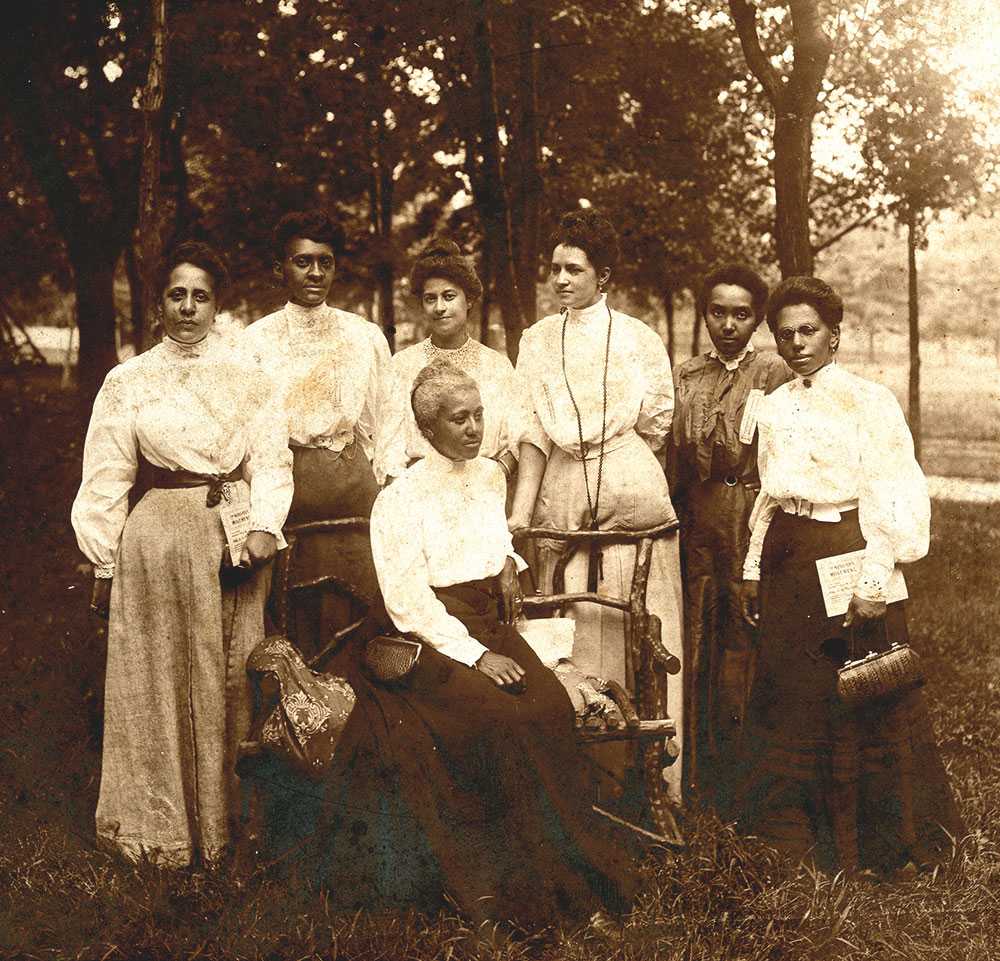Chapter 1
Debating the Path Forward
In 1903 scholar and civil rights leader W. E. B. Du Bois warned that “the problem of the 20th century is the problem of the color-line.” The solution to the problem depended upon African Americans’ resistance.
Black Activism in the Early 20th Century
Junior Auxiliary NAACP delegates in Cleveland, Ohio with W. E. B. Du Bois (center), 1929
As the 20th century began, African Americans faced increasing violence and laws restricting their rights. In response, activists came together to form new national organizations. These groups used lobbying, protest marches, and other tactics to defend African Americans’ rights to be treated as equal citizens.
The National Association of Colored Women’s Clubs
Banner with NACWC motto
NACWC pin
By 1896 organizations of African American clubwomen were common around the country. That year the two largest national groups—the National Federation of Afro-American Women and the National Colored Women’s League—merged to form the National Association of Colored Women. In 1904, the organization was incorporated as the National Association of Colored Women’s Clubs (NACWC).
Their motto was “Lifting as We Climb” and their goal was both moral and material uplift. Within 20 years the NACWC had more than 50,000 members in 1,000 clubs nationwide.
Women’s Groups
After slavery, African American women created local clubs and organizations in the 1870s and 1880s. Led mainly by middle-class women, these organizations focused on social, religious, cultural, and political issues. Many African American women believed they had a responsibility to work with poor or struggling members of their communities.
The Niagara Movement
Niagara Movement Founders, 1905
Women at the Niagara Movement Conference at Harpers Ferry, 1906
In 1905 a group of 29 men met on the Canadian side of Niagara Falls to form a new organization—the Niagara Movement. They believed that lobbying and protest were the best ways to improve African American life. The group lobbied politicians for protection of voting rights and greater economic and educational opportunities. “We claim for ourselves,” they declared, “every single right that belongs to a freeborn American.”
By the time of the second meeting in 1906, women were encouraged to join. The bylaws were amended to state: “Properly qualified persons may be admitted to the Niagara Movement without distinction of sex.” Half of the delegates to the 1907 meeting were women and women took an active role in promoting the organization’s ideals.
National Association for the Advancement of Colored People
NAACP Founders
The 1908 race riot in Springfield, Illinois, and the growing number of lynchings nationwide prompted a group of concerned citizens to call a meeting to discuss racial justice.
Sixty people, including seven African Americans, responded to the call. Out of this meeting the National Association for the Advancement of Colored People (NAACP) was formed in February 1909. Its mission was “to ensure the political, educational, social and economic equality of minority group citizens of United States and eliminate race prejudice.”
Attendees of the 20th Annual NAACP meeting in Cleveland, Ohio
The National League for the Protection of Colored Women
Frances Alice Kellor
Women and children in front of a boardinghouse
Founded in 1906 by Frances Kellor, a white reformer, and Sarah Willie Layten, a Black activist, the National League for the Protection of Colored Women helped African American women who migrated to northern cities. Most of these migrants were domestic workers who labored under difficult conditions. Members of the League helped new arrivals find housing, jobs, and protection from criminals seeking to draw them into prostitution.
The Urban League
George Edmund Haynes
The Urban League was formed in New York in 1910 to aid African Americans migrating from the South. George Edmund Haynes, its first executive director, and Ruth Standish Baldwin were both central to the Urban League’s creation. An interracial organization with a focus on economic empowerment, the Urban League trained social workers, helped migrants find employment, and conducted studies about the conditions newcomers faced.
Urban League, Detroit
The Detroit Urban League
The Detroit Urban League community center housed a newborn clinic, health facilities, educational programs, and recreational activities.
Urban League, Pittsburgh
The Urban League of Pittsburgh
The Urban League of Pittsburgh supported the influx of Black migrants who moved to the city during and after World War I.
